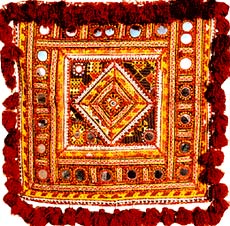 Embroidery Work in India is carried out in Punjab, Uttar Pradesh, West Bengal and many other regions. Buttonhole or Blanket Stitch, Running Stitch, Cross Stitch, Satin Stitch and Chain Stitch are some of basic techniques of stitching used in Indian Embroidery. It has also given way to machine stitching with the advent of the industrial era. There are diverse varieties of Indian embroidery.
Embroidery Work in India is carried out in Punjab, Uttar Pradesh, West Bengal and many other regions. Buttonhole or Blanket Stitch, Running Stitch, Cross Stitch, Satin Stitch and Chain Stitch are some of basic techniques of stitching used in Indian Embroidery. It has also given way to machine stitching with the advent of the industrial era. There are diverse varieties of Indian embroidery.Influenced by a variety of cultures, India has downed during numerous invasions and settlements and Indian embroidery from all regions has an essence of its own.
History of Embroidery in India
Themes and designs have stayed as such for centuries. In the pre-historic civilization, it was the same embroidery needles which have been found in excavations. The patterns have always been floral, animals, geometric and religious. Each embroidery style has its own history and a story of expansion. Indian embroidery receives its inspiration from nature and religion. The colours, the bottom, the subject matter and the fashion, all are reflective of a particular area. Embroidery on leather, velvet, net, cotton and silk are through all over the country. The patterns are decided upon on the base of the fabric and its quality with the stitches depends upon the style and the produce to be created.
Materials for Indian Embroidery
The materials used in Indian embroidery like the fabrics and yarns vary from one place to another. Silk, wool and linen are predominantly used for thousands of years for both fabric and yarn. In the recent times, the thread used in traditional embroidery is manufactured in rayon, cotton, as well as traditional wool, silk and linen. In the techniques of canvas work, huge quantities of thread are buried on the back of the work to use more materials but provide a sturdier and more substantial finished textile. Further, in surface as well as canvas work techniques, an embroidery frame is generally used for stretching the material as it ensures that any sort of pattern distortion.
For more, visit the link below: